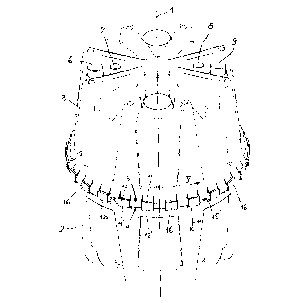Une partie des informations de ce site Web a été fournie par des sources externes. Le gouvernement du Canada n'assume aucune responsabilité concernant la précision, l'actualité ou la fiabilité des informations fournies par les sources externes. Les utilisateurs qui désirent employer cette information devraient consulter directement la source des informations. Le contenu fourni par les sources externes n'est pas assujetti aux exigences sur les langues officielles, la protection des renseignements personnels et l'accessibilité.
L'apparition de différences dans le texte et l'image des Revendications et de l'Abrégé dépend du moment auquel le document est publié. Les textes des Revendications et de l'Abrégé sont affichés :
| (12) Demande de brevet: | (11) CA 2234378 |
|---|---|
| (54) Titre français: | RECIPIENT |
| (54) Titre anglais: | CONTAINER |
| Statut: | Réputée abandonnée et au-delà du délai pour le rétablissement - en attente de la réponse à l’avis de communication rejetée |
| (51) Classification internationale des brevets (CIB): |
|
|---|---|
| (72) Inventeurs : |
|
| (73) Titulaires : |
|
| (71) Demandeurs : |
|
| (74) Agent: | SMART & BIGGAR LP |
| (74) Co-agent: | |
| (45) Délivré: | |
| (22) Date de dépôt: | 1998-04-06 |
| (41) Mise à la disponibilité du public: | 1998-10-11 |
| Licence disponible: | S.O. |
| Cédé au domaine public: | S.O. |
| (25) Langue des documents déposés: | Anglais |
| Traité de coopération en matière de brevets (PCT): | Non |
|---|
| (30) Données de priorité de la demande: | ||||||
|---|---|---|---|---|---|---|
|
Le récipient se compose de deux coquilles qui se font face et qui sont assemblées par leur bord ouvert au moyen de structures de fixation coniques. A cette fin, chaque coquille comprend une pluralité de demi-cônes distribués le long de la circonférence. Deux demi-cônes opposés des deux coquilles se complètent pour former un cône entier. Une bride conique fournie séparément se glisse par-dessus chaque cône entier, laquelle enserre le cône entier et presse l'un contre l'autre les deux demi-cônes de chaque cône entier et conséquemment les deux bords ouverts. Enter the French Abstract here.
The container consists of two shells which face
each other and are mounted to each other at their port edges
by means of wedge type fastener structures. To this end each
shell includes a plurality of semi-wedges arranged distributed
along the circumference. Two opposite semi-wedges of the
two shells complete themselves to a complete wedge. A
separately provided wedge clams is slid over every complete
wedge, which wedge clamp grips around the complete wedge and
presses the two semi-wedges of each complete wedge and
accordingly the two port edges together.
Note : Les revendications sont présentées dans la langue officielle dans laquelle elles ont été soumises.
Note : Les descriptions sont présentées dans la langue officielle dans laquelle elles ont été soumises.

2024-08-01 : Dans le cadre de la transition vers les Brevets de nouvelle génération (BNG), la base de données sur les brevets canadiens (BDBC) contient désormais un Historique d'événement plus détaillé, qui reproduit le Journal des événements de notre nouvelle solution interne.
Veuillez noter que les événements débutant par « Inactive : » se réfèrent à des événements qui ne sont plus utilisés dans notre nouvelle solution interne.
Pour une meilleure compréhension de l'état de la demande ou brevet qui figure sur cette page, la rubrique Mise en garde , et les descriptions de Brevet , Historique d'événement , Taxes périodiques et Historique des paiements devraient être consultées.
| Description | Date |
|---|---|
| Inactive : CIB de MCD | 2006-03-12 |
| Inactive : CIB de MCD | 2006-03-12 |
| Demande non rétablie avant l'échéance | 2004-04-06 |
| Le délai pour l'annulation est expiré | 2004-04-06 |
| Réputée abandonnée - omission de répondre à un avis sur les taxes pour le maintien en état | 2003-04-07 |
| Inactive : Abandon.-RE+surtaxe impayées-Corr envoyée | 2003-04-07 |
| Réputée abandonnée - omission de répondre à un avis exigeant une traduction | 1999-11-17 |
| Inactive : Supprimer l'abandon | 1999-05-04 |
| Inactive : Correspondance - Formalités | 1998-11-30 |
| Inactive : Incomplète | 1998-11-17 |
| Demande publiée (accessible au public) | 1998-10-11 |
| Inactive : CIB attribuée | 1998-07-30 |
| Inactive : CIB enlevée | 1998-07-30 |
| Inactive : CIB en 1re position | 1998-07-30 |
| Symbole de classement modifié | 1998-07-30 |
| Inactive : CIB en 1re position | 1998-07-30 |
| Inactive : CIB attribuée | 1998-07-30 |
| Modification reçue - modification volontaire | 1998-07-06 |
| Inactive : Certificat de dépôt - Sans RE (Anglais) | 1998-06-17 |
| Exigences de dépôt - jugé conforme | 1998-06-17 |
| Demande reçue - nationale ordinaire | 1998-06-16 |
| Date d'abandonnement | Raison | Date de rétablissement |
|---|---|---|
| 2003-04-07 | ||
| 1999-11-17 |
Le dernier paiement a été reçu le 2002-02-18
Avis : Si le paiement en totalité n'a pas été reçu au plus tard à la date indiquée, une taxe supplémentaire peut être imposée, soit une des taxes suivantes :
Veuillez vous référer à la page web des taxes sur les brevets de l'OPIC pour voir tous les montants actuels des taxes.
| Type de taxes | Anniversaire | Échéance | Date payée |
|---|---|---|---|
| Taxe pour le dépôt - générale | 1998-04-06 | ||
| TM (demande, 2e anniv.) - générale | 02 | 2000-04-06 | 2000-03-16 |
| TM (demande, 3e anniv.) - générale | 03 | 2001-04-06 | 2001-03-02 |
| TM (demande, 4e anniv.) - générale | 04 | 2002-04-08 | 2002-02-18 |
Les titulaires actuels et antérieures au dossier sont affichés en ordre alphabétique.
| Titulaires actuels au dossier |
|---|
| OTTO PETER GRAF |
| Titulaires antérieures au dossier |
|---|
| S.O. |